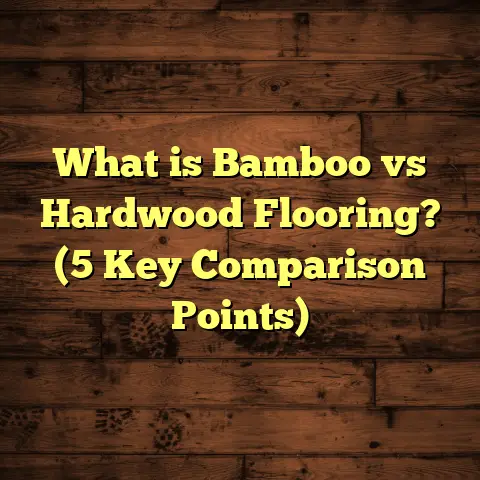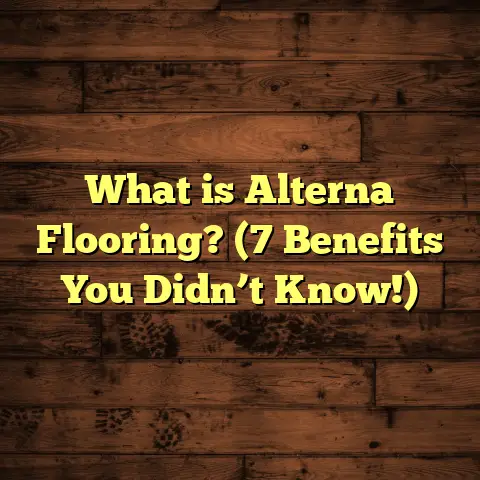What is Better: Laminate or Vinyl Floor? (5 Key Differences Explained)
A Chat About Floors: Laminate vs. Vinyl — Which One’s Better?
If you’re like me and enjoy hobbies that involve creativity and attention to detail—maybe woodworking, crafting, or even just rearranging your living space—you know how much the right flooring can change the vibe of a room. I’m always fascinated by how floors not only support our daily steps but also set the tone for everything else. When it came time for me to redo my own floors, I found myself stuck between two popular options: laminate and vinyl. So I dug deep into what makes each special and how to choose the best fit depending on lifestyle, budget, and style.
Let’s break down what you really need to know about these two flooring choices, based on my personal experience, research, and a few conversations with flooring pros.
What’s Really Going on with Laminate and Vinyl Flooring?
Before getting into the nitty-gritty differences, let’s take a closer look at what laminate and vinyl floors actually are.
Laminate flooring is a multi-layer synthetic product fused together through high heat and pressure. Its core is usually made of high-density fiberboard (HDF), which provides strength and stability. On top of that core lies a photographic layer that replicates real wood, stone, or other textures with remarkable realism. The final top layer is a transparent wear layer that guards against scratches, stains, and fading caused by sunlight.
I remember being surprised at how much technology goes into the photographic layer—it’s not just a flat image but often textured to mimic natural wood grain or stone surfaces. This layering system makes laminate sturdy and cost-effective.
Vinyl flooring, on the other hand, is made from polyvinyl chloride (PVC) resin blended with plasticizers to give it flexibility. It can come in sheets, tiles, or planks. Vinyl’s appeal has skyrocketed with luxury vinyl planks (LVP) and luxury vinyl tiles (LVT), designed to closely mimic hardwood, stone, or ceramic tile. What makes vinyl stand apart is its waterproof nature—this is due to its synthetic makeup and sealed surface.
Interestingly, advancements in vinyl printing and embossing techniques mean you get very realistic textures and patterns now—far beyond the old-school plain vinyl sheets.
Both materials offer a practical alternative to solid hardwood or natural stone but serve different needs depending on where you plan to install them.
1. Durability: What Holds Up Better Over Time?
I’ve always been curious about how well laminate and vinyl floors can hold up over time in a busy household setting. After all, floors take a beating from pets, kids, furniture moving, and everyday foot traffic.
Laminate Durability
The durability of laminate flooring comes from its tough wear layer that creates a hard surface resistant to scratches and dents. When I installed laminate in my living room five years ago, I was worried about my dog’s nails scratching it. To my surprise, after years of wear, there were only minor scuffs that didn’t affect the overall look.
Laminate is made to resist fading from sunlight too. This is especially important in rooms with large windows or lots of natural light. However, laminate is sensitive to moisture. If water seeps into the seams or ends of planks, it can cause swelling or warping—something I experienced once when a pipe leaked under the floor. Cleaning with water needs to be done cautiously.
According to data from the National Wood Flooring Association (NWFA), laminate lasts roughly 15-25 years with proper maintenance. The key here is keeping moisture away and avoiding heavy impact damage.
Vinyl Durability
Vinyl flooring’s strength lies in its water resistance and flexibility. My kitchen has luxury vinyl plank flooring because spills and dropped utensils happen often. The vinyl has held up without warping or staining even after multiple years.
Vinyl also resists dents better than many expect—especially high-quality LVP/LVT with thick wear layers (usually 12 mil or more). Commercial-grade vinyl can last upwards of 20 years due to added toughness.
One thing I learned from talking with contractors is that vinyl can sometimes dent under very heavy furniture or sharp objects but generally bounces back better than laminate when exposed to minor impact.
Real-World Durability Case Study
I spoke with a family who installed laminate on their main floor and vinyl in bathrooms/kitchen:
- After 7 years, laminate looked great in the living areas but showed wear near entrances where moisture was tracked in.
- The vinyl in wet zones remained intact without any swelling or discoloration.
This reinforced my view that selecting based on room conditions matters more than just durability ratings alone.
2. Installation: How Easy Is It to Get Them Down?
I enjoy hands-on projects, so installation was something I researched deeply before starting my own floor makeover.
Laminate Installation
Laminate flooring typically uses a click-and-lock system where planks snap together over an underlayment without nails or glue. This “floating” method makes installation faster and easier for DIYers like me.
However, there are some caveats:
- The subfloor must be perfectly level; uneven floors cause gaps or creaking.
- Cutting planks to fit edges or corners requires precision.
- Expansion gaps around room edges are necessary to allow for natural movement.
I remember spending a weekend installing laminate in my bedroom—it was satisfying but demanded patience during tricky cuts around door frames.
Vinyl Installation
Vinyl installation varies by type:
- Sheet vinyl requires careful measuring and cutting to avoid wrinkles or bubbles.
- Luxury vinyl planks (LVP) often have a click-lock floating system similar to laminate.
- Vinyl tiles can be peel-and-stick or glued down for extra security.
What surprised me was how forgiving vinyl is on imperfect subfloors compared to laminate. Its flexible nature allows it to conform better without visible flaws.
For someone less experienced with tools, vinyl plank or tile installation might feel easier. Sheet vinyl installation is best left to pros due to complexity.
Installation Time & Cost Insights
In terms of time:
- Installing laminate in a 300 sq ft room took me about two days including prep.
- Vinyl plank installation can be similar or faster due to fewer cutting adjustments for some rooms.
- Sheet vinyl installation took pros I know about one day for a similar area but required adhesive drying time.
Cost-wise, professional installation runs roughly $2-$8 per square foot for both materials but DIY saves money if you have the right skills.
3. Maintenance: What’s Less Hassle Over Time?
How floors fit into your cleaning routine is a big deal for busy households like mine.
Laminate Maintenance
Laminate needs dry cleaning methods such as sweeping or vacuuming regularly. Water-based mopping is tricky because excess water can seep between seams causing damage. I learned that microfiber mops with minimal moisture work best.
Stains like pet accidents must be cleaned quickly using gentle cleaners designed for laminate floors.
One big plus is that laminate does not require waxing or polishing.
Vinyl Maintenance
Vinyl is far more low-maintenance in my experience:
- You can mop with water or mild detergents without worrying about damage.
- Stains wipe off easily.
- No special treatments like waxing are needed.
- The waterproof nature means spills don’t soak in or cause warping.
For homes with kids or pets, vinyl cuts down cleaning effort considerably.
Long-Term Maintenance Costs
Over time, laminate might require replacement of damaged planks due to moisture exposure—something that doesn’t happen with vinyl unless severely scratched or punctured.
Vinyl floors generally stay looking new longer with less upkeep cost involved.
4. Appearance: Which Looks More Like the Real Thing?
For me, aesthetics played a huge role because I wanted floors that felt warm and inviting rather than cheap-looking.
Laminate Appearance
High-quality laminate flooring often comes with textured surfaces that replicate wood grain patterns beautifully. You can find laminate that mimics oak, maple, walnut, even exotic hardwoods convincingly.
The photographic layer can capture fine details like knots and color variations which add realism.
However, some cheaper laminates still look artificial—flat surfaces and repetitive patterns give them away.
Vinyl Appearance
Vinyl flooring has made huge leaps forward recently:
- Luxury Vinyl Plank (LVP) features embossing that mimics wood grain texture.
- Color matching technology creates natural-looking hues.
- Vinyl tile options mimic stone or ceramic tile textures impressively well.
I tested samples side-by-side with hardwood and was genuinely impressed by luxury vinyl’s visual fidelity—especially once installed.
Lighting & Texture Effects
One insight I discovered: lighting affects perception heavily. Matte finishes on both materials look more natural than shiny surfaces which reflect light unnaturally.
Texture helps disguise imperfections like scratches or dents over time, making floors feel lived-in rather than plastic-like.
5. Cost: What Fits Better in Your Wallet?
Budgeting was one of the most practical parts of choosing between laminate and vinyl floors for me.
Material Costs
- Laminate typically costs $1-$5 per square foot depending on brand quality.
- Vinyl sheet ranges $1-$4 per square foot; luxury vinyl planks $3-$7 per square foot.
Higher-end laminates tend to be cheaper than luxury vinyl options but still provide good looks.
Installation Costs
Professional installation generally adds $2-$8 per square foot for both materials depending on complexity and location.
DIY installation saves money but requires time investment and skills.
Long-Term Cost Efficiency
While initial costs matter, I also considered lifetime expenses:
- Vinyl’s water resistance reduces risk of costly repairs.
- Laminate may need partial replacement if damaged by moisture.
Using FloorTally helped me estimate realistic project budgets factoring in materials, labor, waste factor (usually 5-10%), plus extras like underlayment or subfloor prep.
Additional Considerations Based on Personal Experience
Comfort & Sound
Laminate tends to feel harder underfoot than vinyl due to its rigid core. Standing on laminate for long periods felt tiring when I worked from home at my desk. Vinyl’s softer surface added comfort.
Sound-wise, laminate can sound hollow when walked on unless installed over quality underlayment designed for noise reduction. Vinyl generally absorbs impact sound better naturally.
Environmental Impact
I found out that:
- Laminate uses wood byproducts but includes synthetic resin binders.
- Vinyl is fully synthetic—derived from petroleum products—and less biodegradable.
If eco-friendliness matters to you, consider looking for low-VOC certified products or brands using recycled content.
Resale Value
From talking with real estate agents:
- Real hardwood floors still command highest resale value.
- Both laminate and vinyl are seen as practical choices but don’t add as much value as natural materials.
Still, well-maintained floors in good design styles won’t hurt your home’s appeal.
Stories From the Field: Real Homeowners’ Journeys
One friend of mine installed laminate across her entire home because she loved the authentic wood look but found it challenging in bathrooms where moisture caused swelling near showers. She eventually replaced those sections with luxury vinyl planks which held up beautifully over several years now.
Another acquaintance runs a small café and chose commercial-grade vinyl flooring for its durability against spills and heavy foot traffic. They were amazed by how easy cleanup became compared to their previous tile floor which required grout cleaning constantly.
These stories highlight why knowing your environment helps choose wisely rather than grabbing what’s trendy or cheapest upfront.
Comparing Laminate & Vinyl With Other Flooring Options
How do these stack against hardwood or tile?
| Flooring Type | Average Cost per Sq Ft | Durability | Water Resistance | Maintenance | Appearance |
|---|---|---|---|---|---|
| Hardwood | $8 – $12+ | High (requires care) | Low | Needs refinishing | Natural, high-end look |
| Tile (Ceramic/Porcelain) | $5 – $10+ | Very High | Excellent | Requires grout care | Elegant & durable |
| Laminate | $1 – $5 | Moderate | Low | Dry cleaning only | Good wood/stone mimicry |
| Vinyl | $1 – $7 | Moderate – High | Excellent | Easy cleaning | Very realistic (LVP/LVT) |
Hardwood offers beauty but costs far more upfront plus ongoing maintenance hassles. Tile resists water superbly but feels cold underfoot and costs more for installation.
Laminate and vinyl fit nicely between price & performance for families wanting style without breaking the bank.
Final Thoughts on Choosing Between Laminate & Vinyl Flooring
So many factors influence which flooring works best:
- Moisture exposure? Go vinyl.
- Scratch resistance needed? Laminate may be better.
- Budget tight? Both offer options at affordable price points.
- DIY install? Both doable; vinyl slightly easier on uneven subfloors.
- Comfort & sound? Vinyl softer & quieter.
- Appearance preference? High-end laminates look slightly more realistic; luxury vinyl is catching up fast.
Personally, I settled on a mix—laminate in living rooms/bedrooms for warmth and aesthetics; vinyl in kitchens/bathrooms for resilience and ease of care.
If you want help crunching numbers for your project budget, using tools like FloorTally will make your planning painless by providing detailed material/labor costs based on your location plus waste factors so you buy exactly what you need without surprises.
Ready to chat more about flooring options? Whether you want tips on installation tricks or need help choosing brands/models based on your lifestyle, just ask! I’ve explored this topic extensively because picking the right floor means investing in comfort and style that lasts years—something worth getting right from the start.





